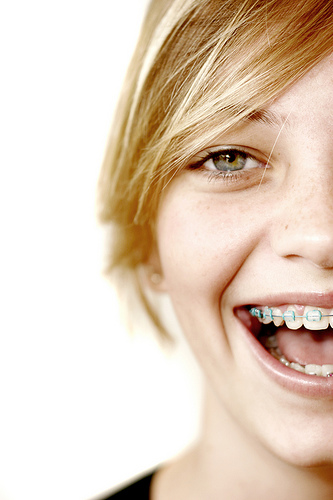September 12th, 2016
| Fitting Braces into Your Life |
| When you’re wearing braces, there are a few things you’ll have to adjust to get the optimal results in the shortest amount of time. If you have any questions about the “do’s and don’ts” of living with braces, feel free to ask our team at your next appointment.
Eating
When you have braces, there are a few types of foods that can damage your brackets and bend your wires, leading you to more appointments and longer treatment times. By simply avoiding sticky, chewy, crunchy, and hard foods, as well as foods like corn on the cob, your orthodontic experience will be smoother and will help prevent unnecessary emergency visits.
Cleaning
Maintaining a clean mouth takes focused attention, more so when you are undergoing  orthodontic care. You’ll never believe the amount of food that can get lodged between your braces when you eat. Plaque buildup as a result of poor brushing and flossing habits can cause bad breath, or worse, tooth decay! It is so important to brush your teeth after every meal and floss every day. It may seem like a hassle, but it will all be worth it in the end! orthodontic care. You’ll never believe the amount of food that can get lodged between your braces when you eat. Plaque buildup as a result of poor brushing and flossing habits can cause bad breath, or worse, tooth decay! It is so important to brush your teeth after every meal and floss every day. It may seem like a hassle, but it will all be worth it in the end!
Sports
Protecting your smile if you play sports is essential when you have braces, and mouthguards are an ideal solution to protecting your teeth and gums from injury. Some mouthguards work better than others when you’re wearing braces, so check with our team first. We can advise you on the right mouthguard if you plan on participating in any kind of contact sport.
Following these tips throughout your treatment will help ensure you get the results you want from your treatment in a timely manner. If you have any questions, please give our office a call. We are here to help! |
|
Copyright © 2012 Sesame Communications
|
June 2nd, 2016
If you are wearing braces and are planning a vacation, we would suggest that you be prepared. We put together a list of items that will be handy to have with you at all times while you are out of town. They include:
- Toothpick, flosspick, or other interdental cleaners
- Travel toothbrush

- A water bottle or a mini bottle of mouth rinse
- Orthodontic wax to help with discomfort from protruding wires
- A small mirror for examining any possible issues in your mouth
Putting these items together in a “braces/oral hygiene kit” may be wise. You may even buy pre-made braces kits. Please ask us for more information.
If you happen to be on vacation and experience problems reaching our office, we suggest going online and searching for orthodontic practices in your area. Most orthodontists will lend a helping hand to another orthodontic patient and get him or her out of pain or discomfort.
We also suggest avoiding the following foods to prevent broken brackets and/or wire distortion while you are on vacation:
- Chewy, sticky, or gummy food
- Apples, pears, and other whole fruits (cut fruit into wedges before consuming)
- Bagels and hard rolls
- Corn on the cob
- Hard candies, cookies or pretzels
- All varieties of nuts, including peanuts, almonds, and cashews
Finally, if you are wearing clear aligners and happen to lose your tray, don’t worry! Simply put in either the previous tray or the next tray and contact us as soon as you get home!
May 3rd, 2016
Temporomandibular Joint Disorder
Temporomandibular joint disorder (TMD) refers to a set of conditions that involve trouble with your jaw and face muscles. It results from a problem in the temporomandibular joint (TMJ), which is a hinge that connects the temporal bones in your skull, in front of each ear, to your jaw. The joint enables you to talk, yawn, and chew by allowing your jaw to move.
The most common symptoms of TMD include:
- Pain in or around the ear, tenderness of the jaw, and pain when biting

- Jaws that are stuck open or shut without you being able to unlock them
- Grating or popping sounds when you chew, or close or open your mouth
In the absence of dental caries or gum disease, symptoms such as migraines, dizziness, and tinnitus (ringing in the ears) may also indicate TMD.
Risk Factors for TMD
- TMD is more prevalent in women than men.
- The condition is most common among adults between the ages of 20 and 40 years.
- If you have arthritis in the jaw area, movement becomes more difficult and puts a strain on the temporomandibular joint.
- Excessive tooth grinding increases stress on the joint.
- General stress can lead you to clench your teeth and strain facial muscles.
Very often, TMD can be treated with a splint or nightguard. Splints and nightguards are custom-made mouthpieces that fit over your upper and lower teeth, to prevent them from coming together and reduce the effects of clenching or grinding the teeth.
Regardless of the reason for your TMD, a simple visit to our office will help you understand all your treatment options and get you started on a life free of jaw pain.
April 7th, 2016
|
| Ask any child with less-than-perfect teeth about teasing and nicknames and you'll no doubt hear a sad story. We hear them every day – Goofy, Bugs Bunny, Fang. Some fun. There is real substance to such a child's social pain.
 One study on childhood harassment found that misaligned or protruding teeth were the single most common target of name-calling among children. Further, children with orthodontic problems are more subject to bullying than their luckier peers. One study on childhood harassment found that misaligned or protruding teeth were the single most common target of name-calling among children. Further, children with orthodontic problems are more subject to bullying than their luckier peers.
We've all experienced the hostility of childhood epithets – it's part of growing up. But for some of us, the bad memories don't "go away." Early and persistent humiliation can become an adult's psychological baggage.
Part of our task as orthodontists is a social one. We know how a child with a problem bite feels. And we know that it's a preventable situation. We have the means to correct every "bad bite" out there – and with it, the social brutality so devastating to young self-esteem.
We want every child in our community to have the advantages of a normal, healthy countenance. Orthodontic evaluation is the first step. Call us for a consultation. The payback for your child lasts a lifetime. |
|

 orthodontic care. You’ll never believe the amount of food that can get lodged between your braces when you eat. Plaque buildup as a result of poor brushing and flossing habits can cause bad breath, or worse, tooth decay! It is so important to brush your teeth after every meal and floss every day. It may seem like a hassle, but it will all be worth it in the end!
orthodontic care. You’ll never believe the amount of food that can get lodged between your braces when you eat. Plaque buildup as a result of poor brushing and flossing habits can cause bad breath, or worse, tooth decay! It is so important to brush your teeth after every meal and floss every day. It may seem like a hassle, but it will all be worth it in the end!

 One study on childhood harassment found that misaligned or protruding teeth were the single most common target of name-calling among children. Further, children with orthodontic problems are more subject to bullying than their luckier peers.
One study on childhood harassment found that misaligned or protruding teeth were the single most common target of name-calling among children. Further, children with orthodontic problems are more subject to bullying than their luckier peers.









 Website Powered by Sesame 24-7™
Website Powered by Sesame 24-7™